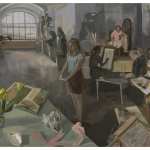
Contributed by Noah Dillon / In Stamford, Connecticut, Franklin Street Works, a non-profit art space with the curatorial vision of a marquis contemporary museum, is presenting �My Vicious Throbbing Heart: Animating Desire in Abstract Painting,� an exhibition of 34 works by a dozen artists. Curated by Risa Puleo, the exhibition aims, in the words of Creative Director Terri C. Smith, to examine �intersections of queerness and abstract painting, including � its current schools of thought, and some of the social themes and technologies that influence it.� Puleo is liberal in her definition of painting, including ceramics, textiles, prints, video, and installation.

She also abandons strictures around abstraction rather quickly. In the first gallery, one confronts Keltie Ferris�s *#*(2017), a duotone monoprint of the artist�s body on paper, which invites comparison David Hammons and Yves Klein�s exploration of painting by using the body as a tool. Ferris�s usual abstraction is absent, supplanting the highly-charged desire of her pixelated paint-and-aerosol canvases for the representational eroticism of a body pressed against � the squeegee of flesh, bristle of hair.

Likewise Matt Morris’s nearby �batons,� poles that span floor to ceiling, draped in ruched satin sleeves printed with images from slide lectures. Those images, reproductions of artworks by women, include pieces by artists in this show, such as Molly Zuckerman-Hartung and Carrie Moyer (both of whom have work on adjacent walls). But the images are largely illegible � shrunk, folded, too high up to be seen. They’re a flow of references and sources, resolving into ceremonious objects accompanied by dried flower petals and perfume in cut-glass vessels set on the floor close by. Morris also presents eight small monochromes that seem related to his invocation of the monochrome painter Marcia Hafif in one of his batons, and certainly to Agnes Martin, from which one takes its cheekily queered name (Fagnes Martin, 2015).


Anna Betbeze�s dyed and injured flokati rug, Mud Bottom(2017), hangs in the stairwell, and looks wildly good in FSW�s domiciliary space. Compressed by hugging walls, it’s got a vitality and danger far greater than what I’ve seen in her AbEx-indebted tapestries in white cube spaces. Here, Betbeze’s shag rug is bisected: the top two-thirds is purple and green and acid yellow with a large white horseshoe at center, while the bottom third is ochre-ish brown, with a few round excisions baring the wall behind. Here is a collision between postwar campy clich�s of sensual romance and postwar painterly Romanticism.

Downstairs, Lisi Raskin‘s painted assemblages look reminiscent of constructivist formalism, such as El Lissitzky’s prouns or recent work by Emily Kiacz. Raskin’s Apart. Together. #4(2018), a black rectangular sculpture, is made of assembled ripped-up bits of plywood with primary colors painted along their rough seams, recalls Ashley Bickerton’s 1980s Neo-Geo self portraits. Laurel Sparks‘s woven, painted, and adorned canvases are gonzo mixed-media extravaganzas with molded papier-m�ch�, glitter, googly eyes, bells, and ash; their surfaces veer quickly from crusty gray sobriety to bananas, and back. Like many of the works on view, Sparks and Raskin’s dramatize the artist’s hand in the materials, and allude to previous abstracted representations of the world and the self.

Finally, in a small viewing room, Leidy Churchman‘s two-channel video Painting Treatments (2010) is shown within an installation by Claire Arctander and Latham Zearfoss. A doorway edged with hanging bundles of ropes marks entry to Arctander and Zearfoss�s a safe space of risk(2018). Beyond the doorway, a small chamber’s floor is filled with painted rocks, like a geologic Sonia Delaunay.

Then there is Churchman�s video, which also has a lot of imagery of painterly floors, and which like those works by Morris and Ferris at the start, bookends the show � not exactly abstract, not exactly painting. The video�s two channels run different lengths, so repeated viewings shuffle synchronies in the twin screens� images. The video features clips of people sitting or laying in a studio space, half-naked in sweaters or fabrics (some of which are evocative of artists such as Daniel Buren or Bridget Riley), while other unknown figures paint them using brushes, pouring, dumping dry powders, adding food, slapping with evergreen branches, coating with newspaper, crushing with pinecones, squirting from bottles, and so on. Much of the video looks like the kind of awkward sloppiness that afflicts many art studios: people futzing around, trying out weird ideas with success, or not. It can also look disturbing and manipulative. At one point, a paint-soaked, gloved hand grabs what I think is Churchman�s shoulder and squeezes hard, in a gesture that makes a beautiful drip of red down the subject�s arm, rather menacingly. There�s an abundance of ritualistic activity, and collaboration, and S&M, and consent, and the results are engrossing. Unlike the other works in the show, much of the agency of representation is absent here, and that�s unsettling in itself.



Painting is a natural, perhaps predictable, way of talking about haptic desire, queer or otherwise. The medium is more or less the solidification of bodily activity, touching luscious fluids and creams � expressive of and dependent on tactility. Moreover, in the contemporary era many Americans confront daily the process of abstracting one’s body. Digital media, for instance, extend our bodies two-dimensionally into realms that are hard to conceptualize. The crafty allure of abstract painting runs the other direction: appearing superficially modest, but drawing into itself all sorts of seductive complications.
“My Vicious Throbbing Heart: Animating Desire in Abstract Painting,� curated by Risa Puleo. Franklin Street Works, Stamford, CT. Through September 9, 2018. Artists include Claire Arctander & Latham Zearfoss, Anna Betbeze, Leidy Churchman, Anne Cousineau, Keltie Ferris, Matt Morris, Carrie Moyer, Lisi Raskin, Sigrid Sandstr?m, Laurel Sparks, and Molly Zuckerman-Hartung
About the author: Artist and critic Noah Dillon has contributed to numerous art publications including The Brooklyn Rail, artcritical Modern Painters, and Frieze.
Related posts:
Examining queer @ Yale University
These threads are queer
Interview: Carrie Moyer in Long Island City













